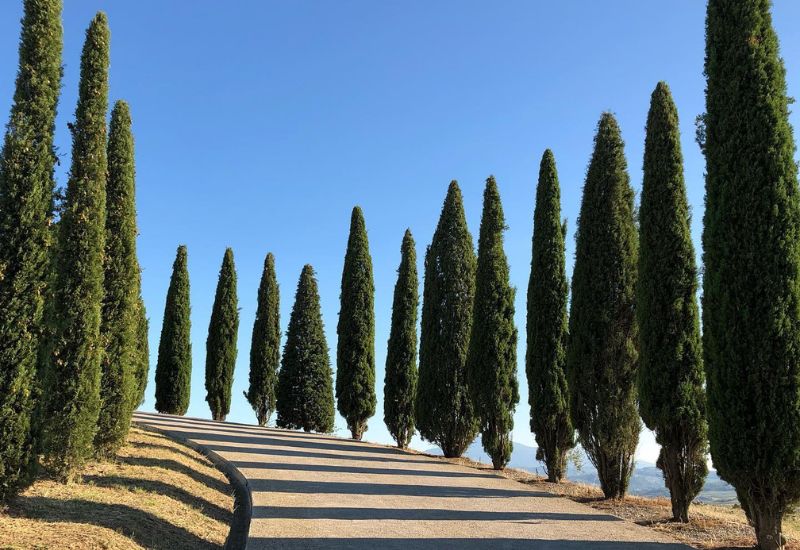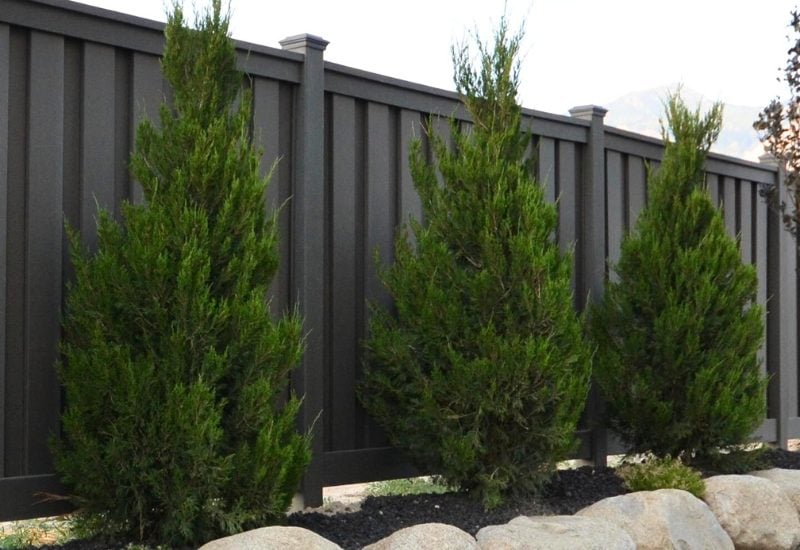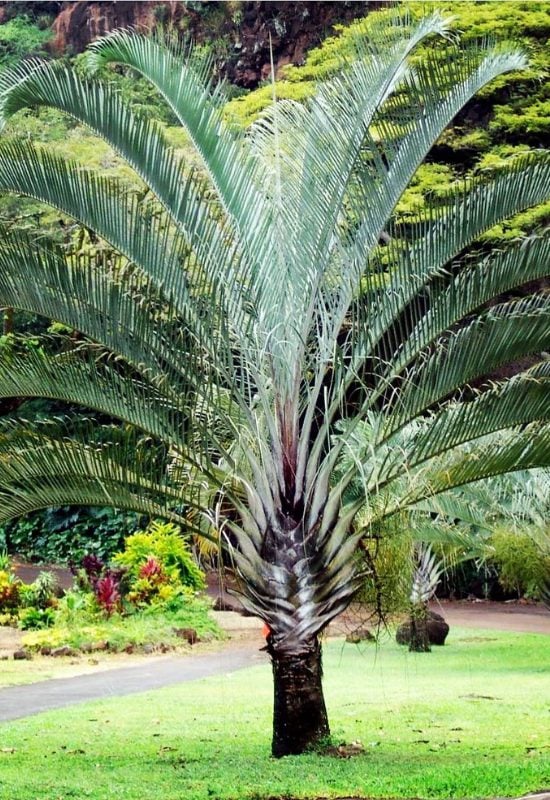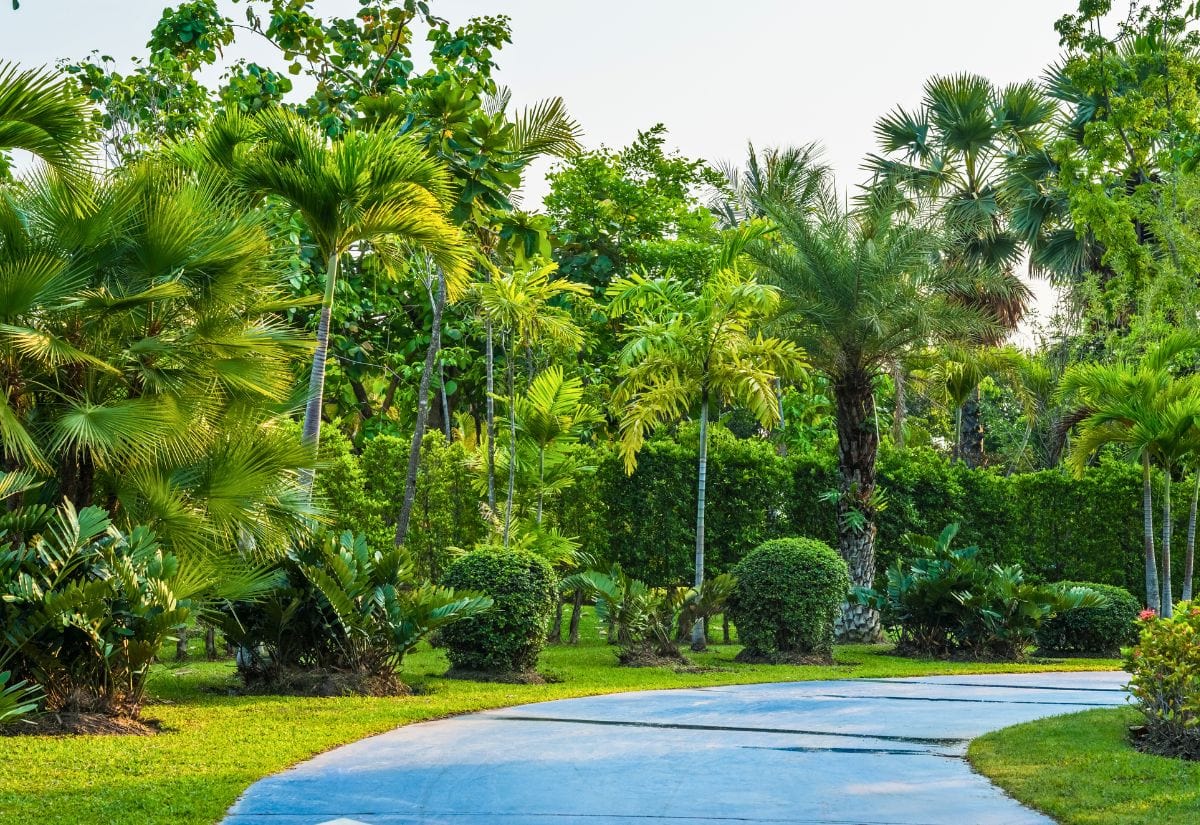
What can be more picturesque and relaxing than driving, riding or also walking along a driveway lined with green, lush and beautiful trees? Not only will you feel and breathe in the fresh and oxygen rich air that comes from their leafy crowns in summer, but you will also feel like your journey is in the very midst of Nature, like in the countryside, or even in a florid forest, and often brightened up by colorful and fragrant flowers as well.
However, picking the right variety of tree for your driveway can be a challenge… Will it fit your garden design and landscape? Will it thrive in the growing conditions you can offer it? Will it be too big, too small, or even too slow growing for you to enjoy the final effect? And what about maintenance?
But fortunately, you have taken the right path, and you are now at a gate; open it and you will find all the best tree varieties for your needs and driveway, and lots of practical tips to make the best choice possible!
How to Choose the Best Trees for Your Driveway – Some Technical Tips
Apart from choosing a variety that grows well in your climate, light conditions, temperature and rainfall, there are a few more things you need to keep in mind to pick the right tree for your driveway. And here they are…
But there is something more to keep in mind…
How to Choose the Best Trees for Your Driveway – Some Aesthetic and Landscaping Tips
But even if you choose a tree variety that matches all the technical aspects you need, of course, you also want that row of green beauties to look good, so, here we go; consider the following.
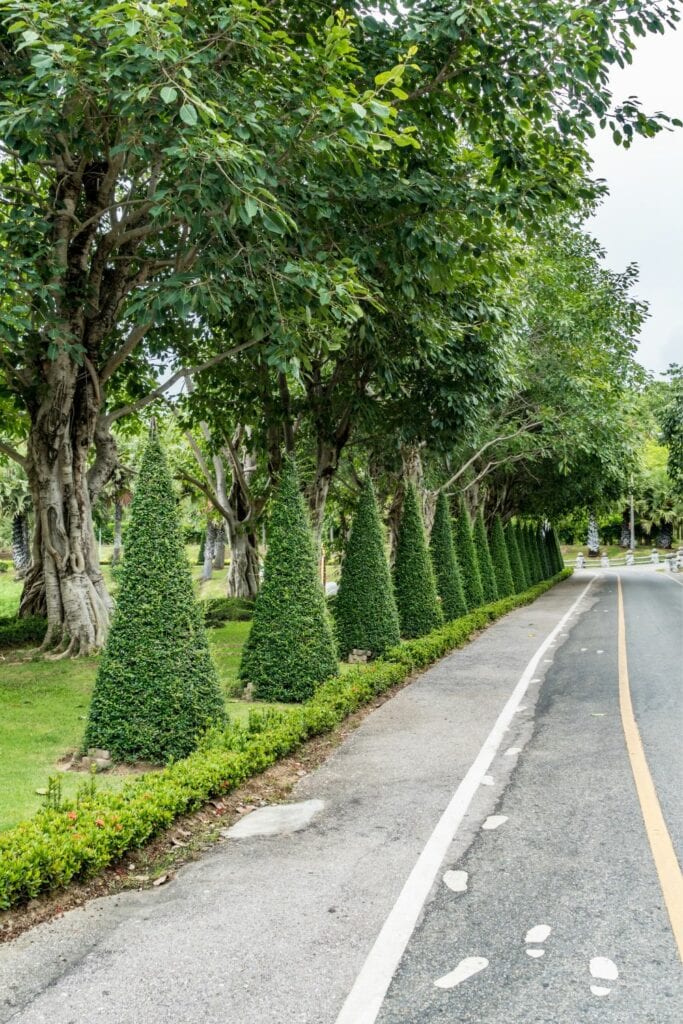
So, now you have some guidance in your very important choice of trees to line your driveway, we can ride on and see which ones are the best varieties!
18 Amazing Trees to Grow on the Sides of Your Driveway
So, let’s go straight to the point… I have lined them up for you, and these are 18 super decorative, leafy and flowering trees that you can grow on the sides of your driveway!
There is no time to waste, and our journey along driveways lined with splendid trees is just waiting for you, so, let’s ride on!
1: Italian Cypress (Cupressus sempervirens)
We could only start our journey with a real classic, Italian cypress. An iconic Mediterranean tree, which lines the sunny countryside roads of many regions of the area, and especially Tuscany, the heart of the Renaissance, these tall and towering giants pinpoint the landscape and punctuate driveways to farms and villas, on the sides of streets.
And you can fully reproduce this effect if your driveway is long, and their columnar habit with pointed tips make them perfect stately or informal pillars to accompany travelers to the heart of your garden… evergreen and with an extremely finely textured foliage, green to bluish in color, but also fragrant, the crown will start very low down the upright trunk, especially when the plant is young.
The cones are small, ovoid and divided into embossed scales, about 1.5 inches in diameter (4.0 cm). But this conifer is all but short, growing to a considerable 70 feet in height (or 21 meters), but its unobtrusive roots make it an ideal choice of you want to preserve your pathway over time.
Apart from its holiday postcard appearance, Italian cypress can offer you two solutions for your driveway. If you plant the trees close to each other, they can literally form a green wall that keeps unwelcome sights off your property all year round.
But if you space them, you can incorporate the surrounding landscape into your garden, and make the best of a sunny and open countryside effect.
2: Florida Maple (Acer floridanum)
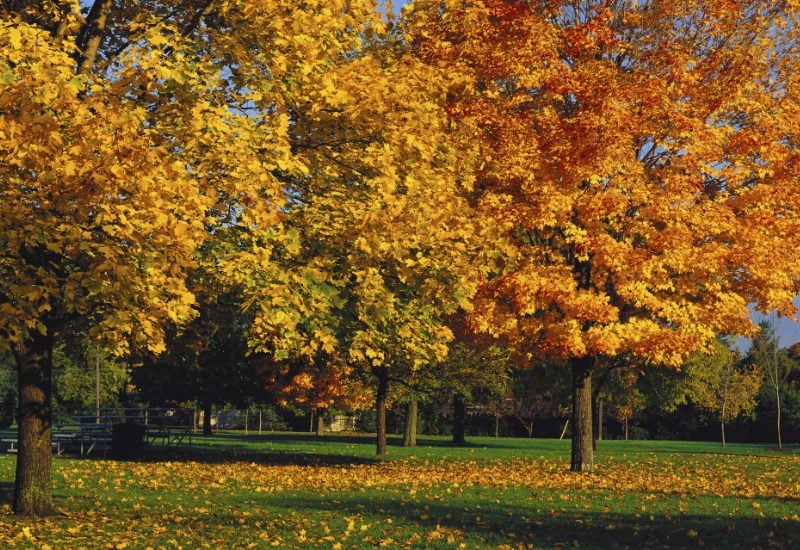
We now travel to another part of the world, and we meet a variety with a totally different look and personality from sunny Italian cypress.
In fact, native to the Atlantic coast of the USA, Florida maple is a medium sized deciduous tree with an open to dense crown with a round, but sometimes broad conical or even pyramidal habit, leaving part of the straight trunk in sight.
This makes it ideal for a shady driveway, also thanks to its broad and palmate foliage, typical of the Acer genus. Each leaf is between 1.2 and 4 inches across (3.0 to 10 cm), with a semi glossy upper page, in tonalities of green ranging from bright hay to mid cadmium and even dark, on the forest side of the range.
April will see it blossoms with clusters of greenish yellow flowers, inconspicuous to be honest, but followed by decorative winged seeds, or samaras, joined in pairs.
You will also enjoy its light gray bark, which is smooth when the plant is young, but it develops cracks when it ages. But maybe it will give you its best spectacle when fall comes, as it explodes into vibrant yellows, oranges and reds…
Fairly cold hardy and temperate looking, Florida maple will suit a driveway in a traditional looking landscape. It is often used to line urban streets, and it will allow you to integrate the surrounding into your design, while giving you plenty of shade.
3: Florida Royal Palm (Roystonea regia)
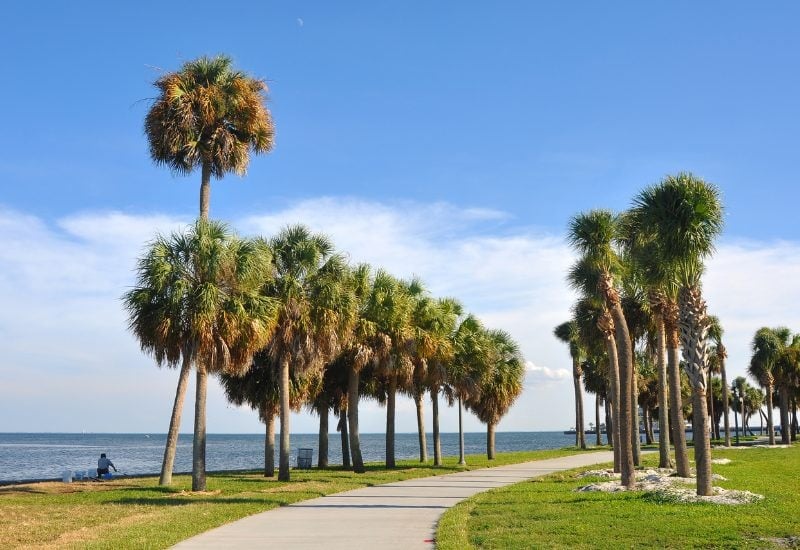
We are now staying local, and we can travel from south Florida to Mexico, Central America and the Caribbean, where Florida royal palm grows spontaneous, and where it lines lots of sunny roads, even leading to enchanted beaches…
In fact, this tree is a favorite for driveways of big villas and mansion, but also for public throughways and roads… and of course it would be, because it is a really sculptural and spectacular tree…
Starting from its feet, you will see a long, straight and smooth grayish trunk rise into the air, like a Greek column, and it has lovely horizontal lines in whitish that give it a marble effect… But looking up, this suddenly changes, as it turns bright and glossy, even shiny pea to jade green for its top part.
On top of it, you will se a rosette of pinnate fronds, arching above your head and with lots of curving leaflets, which are long and narrow, blade like and they wave elegantly in the wind with their lustrous rich green color, and each can be 10 to 15 feet long (3.0 to 4.5 meters)!
The blooms will come just where the two parts of the columnar trunk meet, from mid winter to mid summer, with fluffy and feathery panicles of cream yellowish flowers. They are small and you will have to climb to see them at close range, but they are waxy and with lovely violet purple anthers…
But you may think winter has suddenly come, because they drop white pollen that looks like snow! Each cluster is about 2 feet long (60 cm) and followed by oval fruits that ripen from yellow to red, which are used to make palm oil.
If you want the full on exotic and tropical effect, Florida royal palm will definitely give it to your land and driveway.
It will definitely punctuate your pathway or drive like the columns of an ancient temple, leaving ample gaps to enjoy the surrounding landscape, while providing an impressive sculptural and even architectural element and creating a great perspective.
4: ‘Spartan’ Chinese Juniper (Juniperus chinensis ‘Spartan’)
But what can you do if you don’t live in a hot and sunny country, and your driveway is not on a large or even stately scale?
Enter ‘Spartan’, a cultivar of Chinese juniper that will accompany your guests to your main door, even if the path is short… In fact, this conifer only grows to a maximum of 20 feet (6.0 meters) and it is very cold hardy as well.
But its tall, narrow and pyramidal crown gives you a similar columnar effect of that of Italian cypress, and, like it, it is evergreen.
The crown will start at the very base of the tree, coating the whole upright trunk with very fine foliage, thanks to the many short and and pointed leaves in mid to dark green that grow on the intricate branchlets all year round.
This will allow you to create a dull barrier if you wish, and even a windbreak, to protect the access to your home. Little round, sticky and scaly cones will also appear among the leafy mesh of this beauty, starting off as bright green and ripening to violet purple…
‘Spartan’ Chinese juniper is also very low maintenance and very adaptable to harsh conditions, including cold, heat, drought and salt. But it is also adaptable in terms of landscaping and style.
In fact, it will fit perfectly well into a Mediterranean or coastal garden, but it will equally do the trick on the sides of a driveway in an urban, suburban or traditional and temperate looking green space. You can keep the view open by planting the trees at a distance, or create (or cover) a wall…
5: Italian Stone Pine (Pinus pinaea)
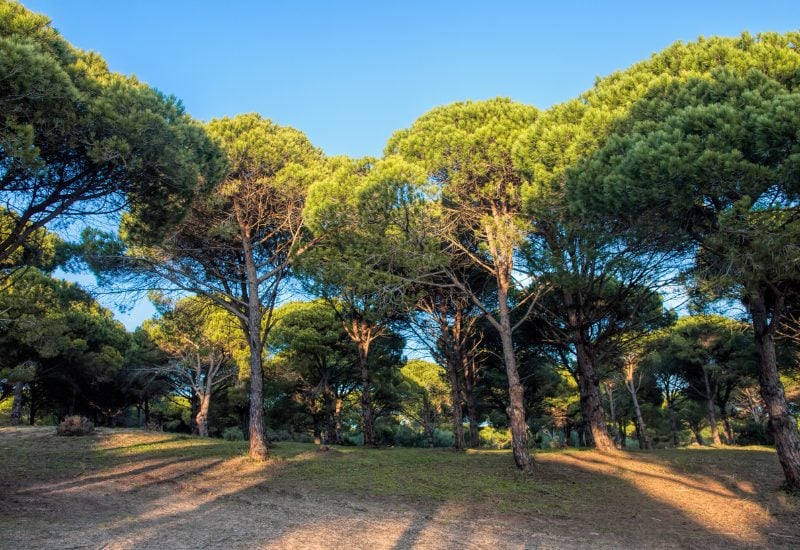
Now we fly back to souther Europe, and I would like you to think about the streets of the eternal city, Rome… What do you see? You see that they are lined up by amazing monuments but also by very unusual looking trees, and these are called Italian stone pines!
Elegant and majestic at the same time, they form an umbrella or mushroom like and dense crown held up high into the air by really artistic branches, and providing very fresh shade, with the many stiff bright to mid green needles.
And of course, being a conifer, this leafy carpet in the sky will last all year round, and it will produce rusty brown comes, that open, and they drop their seeds… But don’t throw them away, because they are the actual delicious, edible and very expensive pine nuts used to flavor pesto…
All this will happen thanks to a sinuous, sometimes gracefully bending trunk with an amazing bark, deep brown in color and very deeply cracked as well.
It is no surprise that this iconic species from the Mediterranean that you can have on the sides of your driveway has won the most prestigious gardening prize of them all, the Award of Garden Merit by the Royal Horticultural Society!
Italian stone pine will definitely bring your landscape to another level… Grow it on the sides of your driveway and you will be transported into another era, and at the heart of the classical world.
But you will need to have beautiful surroundings, because it will leave the sight open to view while providing shade. Its best setting? Maybe on a path or road that that coasts a sunny beach or cliffs on the open sea.
6: Weeping Willow (Salyxbalylonica)
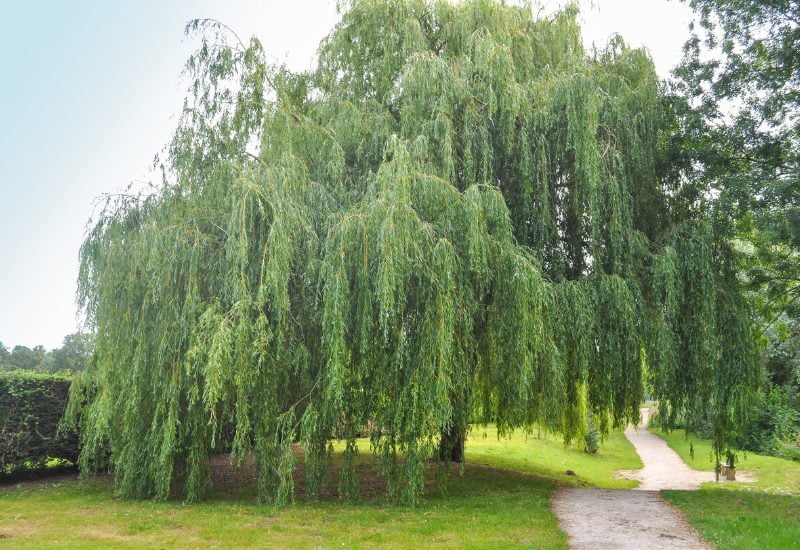
We now move to Asia, where weeping willow comes from (despite its scientific name, Salix babylonica, it is native to China). But we also move to driveways with a totally different look from those we have seen so far…
Of course, you will know that this romantic looking tree has long, pendulous and flexible branches that descend from high above a leafy waterfall, and that the many long and narrow lance shaped (lanceolate) leaves will glitter in the sunlight with bright green and silver all through the season.
However, this crown will wave in the winds of fall with yellow notes as well, before the foliage drops. Yes, being deciduous, its dense and round crown will give you shade and privacy, while it will leave you with an artistic semi see through wall of “threads” during the winter months.
Cream yellow catkins will come when the gems grow into small new leaves, in spring, announcing the year with a fluffy touch, and they grow separately on male and female specimens.
The bark of the stout trunk, straight or bending, is pale brownish gray and with very deep cracks, while on the young branchlets it is smooth a and reddish brown.
But there is more, you can grow weeping willow to line your driveway even if the soil is wet, and it will give its best display if there is a river, canal, pond or ditch to the side.
It will definitely bring a very elegant and soft touch to informal gardens, thanks to its dreamy and old world personality. And it will suit traditional landscapes and well as oriental ones.
7: American Sycamore (Platanus occidentalis)
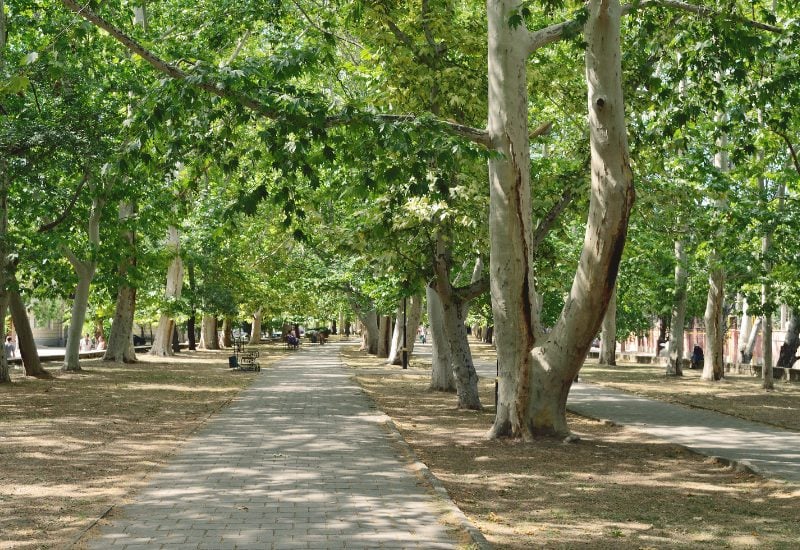
We now need to cross the Atlantic Ocean to meet a native species from North America, and yet another classic: American sycamore!
Also called plane tree, this majestic beauty is arguably the most popular variety you will find on the sides of important urban streets in temperate countries.
This has a function, because it is by far the best choice for polluted areas, as it is a champion of air purification and it tolerates smog.
But it also tells you another thing… You will need a long and broad driveway to accommodate this natural giant, which can grow up to 100 feet tall and in spread (30 meters), and it is fast growing too!
But this will also guarantee you fresh air and lots of shade all through the season, thanks to its dense but half open round or irregular crown, and its broad and lobed leaves, that reach 9 inches across (22.5 cm)… These have a glossy and bright green upper page, while the lower side is glaucous, but the foliage will blush to yellow and orange, even purplish, when fall comes.
Round clusters of fuchsia blooms will dangle from its rising branches in late spring, turning into spherical and fuzzy ball like fruits later on.
While the strong and straight trunks will leave gaps to incorporate the surrounding landscape into your garden, they will also wow you with the spectacle of their flaking bark, which reveals wonderful tonalities of cream, gray, brown, and sometimes, even greenish and purplish in a puzzle like pattern.
An alternative could be London plane tree (Platanus x hispanica), similar but a winner of the Award of Garden Merit by the Royal Horticultural Society.
American sycamore is by far one of the world’s favorite choices for stately driveways, as well as for urban streets and parks.
You can reproduce this majestic effect, punctuating the perspective with its impressive trunks in your garden as well, if you have lots of space, or you may still want one for clean air, maybe as a specimen if you can’t afford a a line…
8: Crepe Myrtle (Lagerstroemia indica)
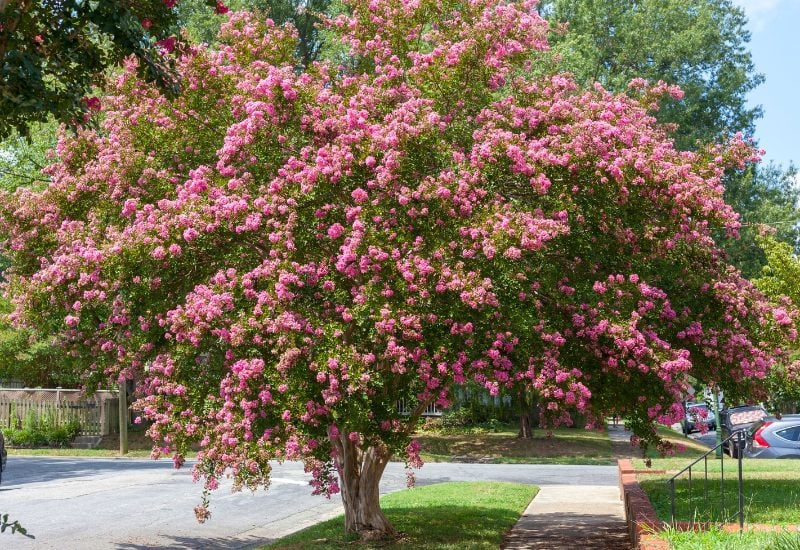
Flying back to the Asian Continent, we find a species that can spark up your driveway with an explosion of colors: crape myrtle!
Native to China, Indochina, the Himalayas and Japan, it is an excellent foundation plant, and this is the reason why it has become very popular all over the world, and many cultivars have been developed…
And from mid summer to early fall, this shrubby tree will accompany your guests and visitors to your main door with crinkly blossoms in shades of white, pink, rose, lavender, red, purple, with different varieties offering you a wide palette, even with sophisticated tonalities like salmon or peach…
And the flowers will come galore, covering the tips of the plants and attracting lots of butterflies, bees and other pollinators to your garden, and you can also choose many sizes, and suit this leafy beauty to your needs. But let’s come to the dense foliage that covers its crown…
The glossy and almost leathery leaves are elliptical and they too come in a range of shades, green in all its range, purple, even almost black, changing throughout the year and acquiring blushes of copper or red, according to the season.
You can also train it into different shapes, allowing it to grow a large and low crown, or a narrow one, for shade, or for sunlight on your path.
You can plant crepe myrtle trees close to each other and grow a leafy, flowering and natural wall against intruding eyes and preserve your privacy, but you can also space them out and let the landscape into your green haven.
It will also suit many styles, from very traditional countryside, English country or cottage designs, to urban, suburban and even oriental.
9: European Aspen (Populus tremula)
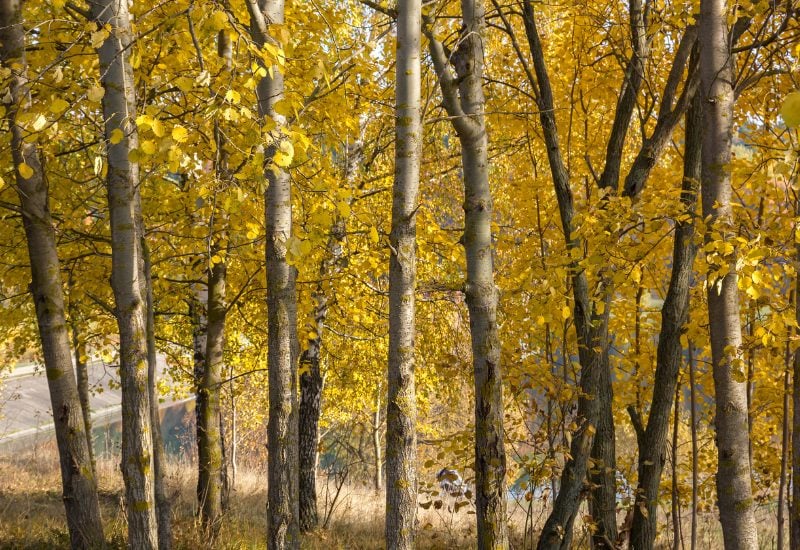
We now travel back to the Old Continent, where, if you drive or ride along countryside roads, you will often see that you are flanked by European (or quaking) aspen… And their tall and straight trunks, allow you to enjoy the view, with their pale grayish bark, smooth when young and finely furrowed when old…
Fast growing to a maximum of 100 feet (30 meters) you will have to look up to see the semi open crown, which forms a columnar, pyramidal or sometimes irregular shape, and it fills it with deltoid leaves with serrated edges.
These have a lovely bright green and semi glossy surface on the upper pages, while the lower sides are silvery, and they shale wonderfully on the upright branches in the wind, or even breeze, thanks to their flattened petiole.
This creates glittering light effects, while the foliage projects fresh dappled shade on the ground. But come fall, this poplar tree will turn yellow and orange, giving you a blushing farewell and final display before the end of the season…
When sprung arrives, long, rabbit tail like catkins with a white fluff will dangle above your head, giving way to drooping fruiting clusters on female specimens.
You will often see European aspen grow on the sides of rivers and especially irrigation ditches and canals on the planes of Europe, and all over the continent, being very cold tolerant.
This tells you that it can thrive in wet conditions, and it really has a rural personality, through it is grown in urban areas as well, maybe to breathe a bit of countryside air on the sides of your pathway.
10: Triangle Palm (Dypsisdecaryi)
If you grow triangle palm to line your driveway, you may think you are a pharaoh riding to an important ceremony every time you come back home… Our journey takes us to Africa now, and in particular, to the island of Madagascar, famous for its very exotic and even alien looking species.
And in fact, our tree is a fine example… It is really hard to describe, but its amazing crown may remind you of a peacock tail, or a massive fan (like those used to keep ancient Egyptian royalty fresh…)
Yes, because its fronds, are form a totally flat surface, like a two dimensional painting, or a hieroglyph, indeed, and they rise up and then arch elegantly at the tips, reaching 10 feet long (3.0 meters).
The leaves are pinnate, and the grass blade like leaflets, many of them, form a V with the mid rib, and then they curl decoratively downwards.
What is more, they have a striking color that could be described as green to blue and silver gray… Where they attach to the trunk, you will see a marble like pattern that may remind you of a Roman legionary’s breast piece, or even – oddly enough – a lobster, at least that’s what it reminds me of…
Below this decorative, sculptural embossing, you will find the lower part of the trunk, which is stocky and up to 20 inches thick (50 cm), smooth and grayish, but with horizontal scars left by fallen foliage.
And then, you will get massive clusters of pale yellow flowers rise up to the sky for as much as 5 feet (1.5 meters) just under the impressive fan; this will usually happen in spring, but this tree may well surprise you and blossom at any time of the year!
Following this spectacular floral display, it will also produce small, smooth and round fruits, that ripen to cream white…
Of course, you will want to grow triangle palm if you want your driveway to look as exotic and tropical as possible. It will produce only light shade, and it is not a big tree, so you van have it in small gardens as well. Leaving open gaps to allow you to enjoy your surroundings, the best way to plant it is with the super sculptural flat fan side facing your drive…
11: Flowering Dogwood (Cornusflorida)
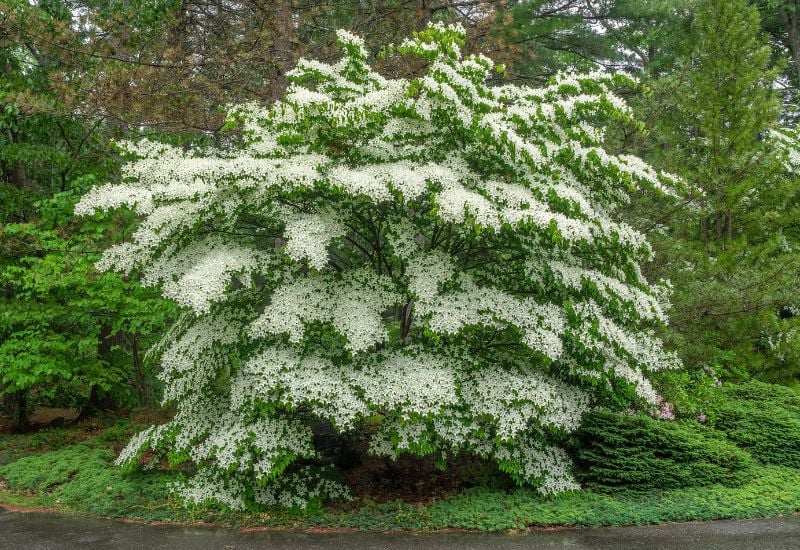
Back to the Americas, you could grow a somewhat exotic but cold hardy variety to wow your guests when they come to visit you: flowering dogwood.
This species is native to Florida, Illinois, Kansas, Mexico, Ontario and Texas, and it can be either a large shrub or a small tree, according to how you train it.
In either case, it will offer your driveway shade with its broad and flat top with elegantly layered, horizontal branches that will shade your drive or path through the season, coated in lots of elliptical and mid green leaves.
But its spectacle will come before they emerge, and in spring, it will literally fill with a very showy floral display!
Tiny greenish flowers in little clusters will appear all over the crown, and these are inconspicuous, but they are framed by four large and round ivory white bracts that are quite showy indeed, the whole bloom reaching 4 inches across.
Then again, there are cultivars in other colors, like ‘Cherokee Chief’ with its rich rose on the cerise range, ‘Cherokee Brave’ with bold magenta stripes, or ‘Cherokee Sunset’ with soft pink…
These are then followed by a harvest of bright red, shiny fruits, which are bitter, and used to flavor ‘eau de vine’ or to make jellies and jams, but they are usually devoured by birds before you can pick them… Finally, before falling as winter approaches, the foliage will give you a final show, turning fiery red and even burgundy purple!
You can grow flowering dogwood to line your driveway as a shrub which will build a natural wall for privacy, or as a tree, leaving the space under the canopy open to the landscape.
What is more, it is adaptable to many styles, from traditional and old world, to exotic and oriental in inspiration, as this species has a mixed, or better fused personality.
12: ‘Fastigata Aurea’ English Yew (Taxus bacata ‘Standishii’)
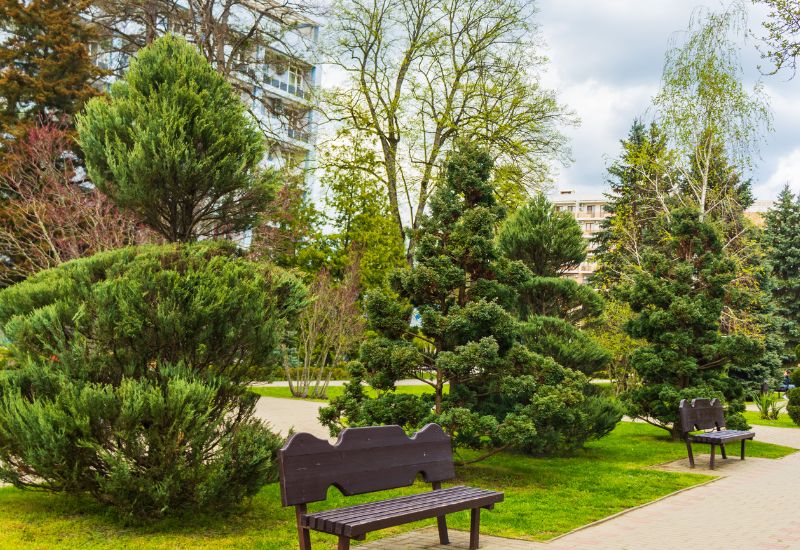
There are quite a few varieties of Taxus bacata you can line your driveway with, but we picked a very special cultivar for you: ‘FastigataAaurea’ English yew.
Technically a shrub, it will look like a columnar tree when you plant it to the sides of your drive, and this is all thanks to its extremely dense, impenetrable cylindrical crown that starts very low down, close to the ground.
The very fine texture of the evergreen foliage of this conifer is due to the many needle like but flat and soft little leaves that coat all its branches all year round, but our variety has something special… While most others have deep green as their color of choice, ‘Standishii’ prefers bright green with golden yellow highlights, and this will keep constant all though the four seasons!
Fairly slow growing, at about 6 to 12 inches per year (15 to 30 cm), you may need to wait till you see it in its full beauty, but it will also suit small spaces and it will give your garden a regular structure year in year.
Of course, it will also grow cones, and these are bright red, small, and shaped like a little cup… For very small gardens, you could pick its sister, ‘Standishii’ which grows to a maximum of 5 feet tall (1.5 meters) and 2 in spread (69 cm), but it has won the Award of Garden Merit by the Royal Horticultural Society!
‘Fastigara Aurea’ English yew will add a golden accent to your garden, and you can grow it as pillars to accompany your driveway, or build a very thick but also luminous and soft looking green and golden wall if you plant these tree like shrubs close together. And it will tolerate virtually all light conditions!
13: Mimosa (Acacia dealbata)
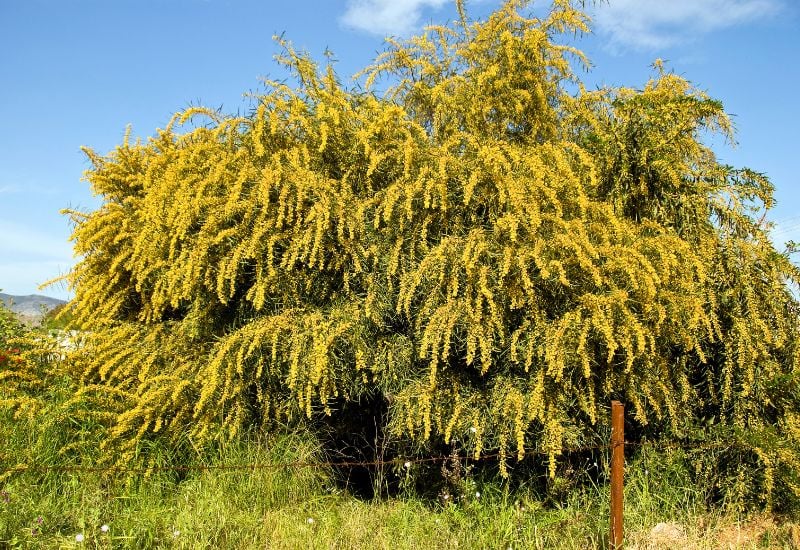
Announce the new season to your visitors and passers by, growing mimosa, or silver wattle on the sides of your driveway! And do it with a bang!
We now fly down under, to meet a medium sized tree or very big shrub from Australia and Tasmania – well, actually, this species has traveled to us, finding sue place in gardens and public spaces in hot and sunny regions all over the word, and especially around the Mediterranean Sea, where it has become a common sight!
From late winter to early spring, this beauty will literally turn totally golden yellow, bringing you lots of light and energy… In fact, lots of racemes with fluffy round blooms will come galore on the branches, giving you a really impressive spectacle.
These clouds of energy will also make your drive smell better, because theyare quite fragrant indeed!
Then, after this jaw dropping floral display, the evergreen foliage will keep your days fresh, thanks to its very finely textured, decorative pinnate leaves, about 3 to 5 inches long (7.5 to 12.5 cm), divided into elegant, elongated and leaflets that look like filigree, and green blue to silver in color.
No wonder it has received the most important gardening prize of all, the Award of Garden Merit by the Royal Horticultural Society!
Yet again, you can plant silver wattle, or mimosa, to line your driveway and have a super decorative barrier against intruding eye, or you can keep your plants as trees, and allow the surrounding landscape into yours. What is more, it will adapt to many garden styles, from Mediterranean (maybe a must have) to urban and suburban.
14: Paper Birch (Betula papyrifera)
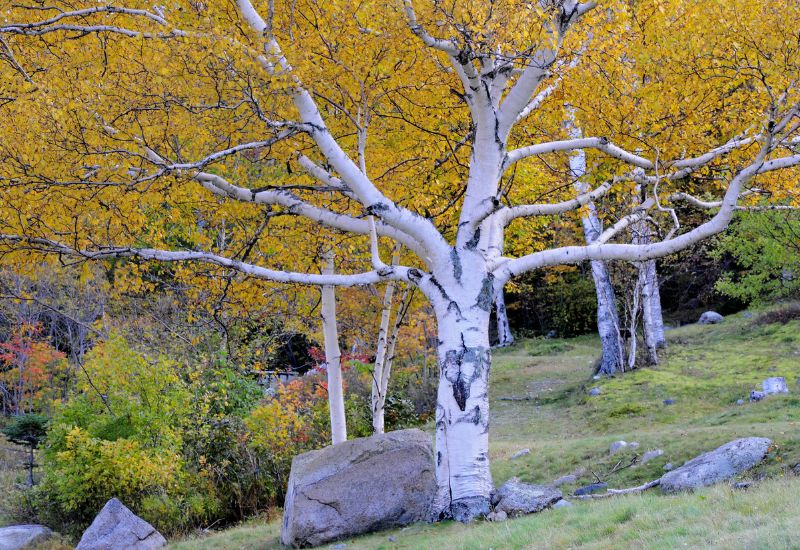
Coming from the deep forests of Canada and the north of the USA, paper birch can also show the way to your main door with its amazing elegance.
Also called white birch, this tree takes its name from the spectacular peeling of its bark… Smooth and cream white, it comes off in horizontal stripes that look like paper, or papyrus, revealing the orangish brown surface underneath.
These can be taken off, and they were used by Native Americans for medical purposes, especially for bandaging, being natural disinfectants… Maybe you won’t need it to heal your wounds, but certainly your driveway will benefit from the line of slim and straight trunks that bear a pyramidal crown above your head… And this will cast soothing dappled shade to the ground, thanks the the many bright green, broad, toothed (serrated) and pointed leaves that quaver in the wind.
Spring will also see it develop brownish yellow drooping male catkins, and greenish but upright female ones… Finally, when fall comes, the foliage will glow with yellows and oranges, wishing you good luck for the winter months!
Very cold hardy and a popular tree for public parks and roads, paper birch with its iconic white trunks will give you a soft looking but very elegant open driveway, whether you live in a rural or urban area.
15: Oleander (Nerium oleander)
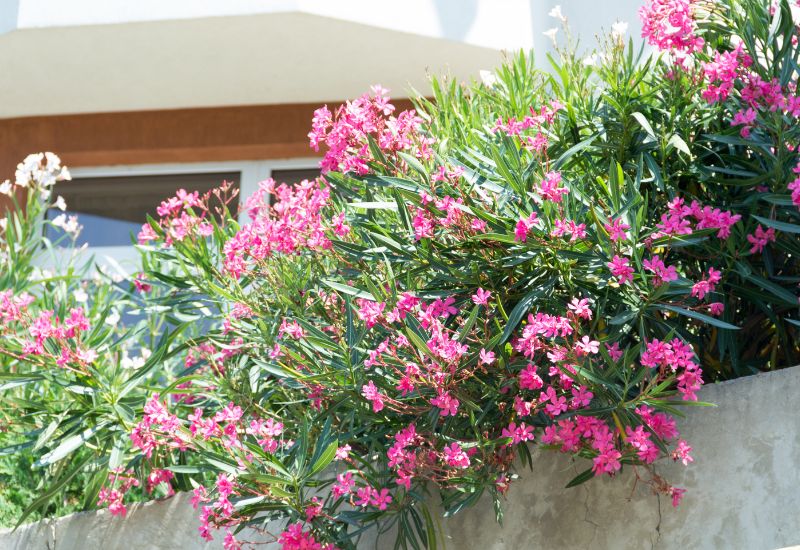
Now we need to go to an appointment to meet the next variety… We will meet halfway, in fact, because oleander is actually native to north Africa and southwest Asia, but it has become a classic of Mediterranean gardens and cities, where it often lines urban and countryside roads.
True, it is classed as a big shrub, but it is easy to train it as a tree; just choose one shoot, and keep that base clean from suckers, and you will get a lovely round crown on top of an upright and straight trunk!
Reaching a very maximum height of 20 feet (6.0 meters), but more often 15 (4.5 meters), it will work well also on short, narrow and sunny driveways. And the long and narrow, pointed almost leathery bright or olive green to bluish leaves will keep you company all year round, being evergreen, dense on the branches.
But summer will come, and this species has some of the most beautiful and generous blossoms, single or double, with a five petals that look like propeller blades, and reaching 2 inches across (5.0 cm).
They will keep coming till early fall, all opening at the tips fro, purplish buds, but then you can choose your variety’s color, with pinks, magenta, deep burgundy, red, salmon and peach.
But if you want a tip, I would pick a white one, because they are the most fragrant of all, with a lovely scent similar to vanilla. And they can start their display floral early and finish late, especially in the right conditions.
Oleander trees can give you a sunny and open driveway, while if you keep it as a shrub, it will guarantee you privacy all year round.
While it does drop a lot of leaves, these also work as excellent weed control, and while it is a Mediterranean icon, it will do the trick also in urban, suburban, traditional and even oriental sunny gardens.
16: Magnolia (Magnolia spp.)
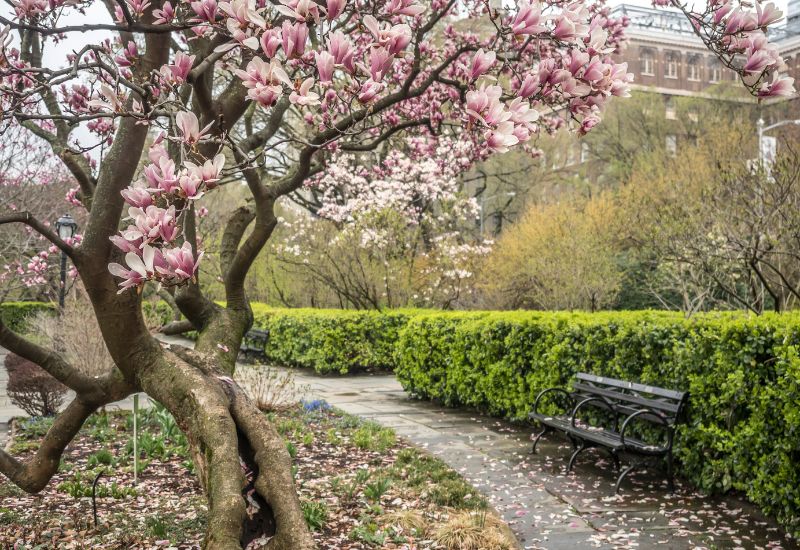
Here is another traveling tree for your driveway, the stupendous magnolia! In fact, it is native only to southern China and the southern USA, but it has become and enchanting presence all over the world.
And maybe it is one of those trees that best express the unique beauty of the Orient… We all recognize its cupped, and tulip like blossoms, but there are also star shaped varieties, and others that open wide.
And the flowers can range from 3 inches across to a whopping 12 inches long (30 cm)! Charming us with their exquisite fragrance, these blooms may also cast a spell on visitors walking up your drive at different times of the year, indeed, from early spring to late summer, depending on your pick!
Then again, you can also choose among a range of colors, whites, pinks, reds, purples and even some yellow ones! What’s more, there are cultivars that range from dwarf to very big, so it doesn’t matter if the way from gate to your main door is only a ten yards or half a mile!
The floral display will be followed by fuzzy cone like fruits, that split open to reveal shiny scarlet seeds. Finally, the foliage… Here again you have ample choice, with evergreen and deciduous trees, but also glossy and leathery oval leaves to less lustrous, and a palette that includes all shades of green, but also purple, especially on the under pages, and copper or bronze through the seasons.
Magnolia trees are arguably some of thebest you can choose to line your driveway! With so many sizes, colors and varieties, surely there is one you can fit in your garden, and while it is a queen of oriental landscapes, it is really suitable to absolutely all designs and inspiration, from countryside to formal.
17: Crabapple (Malus spp.)
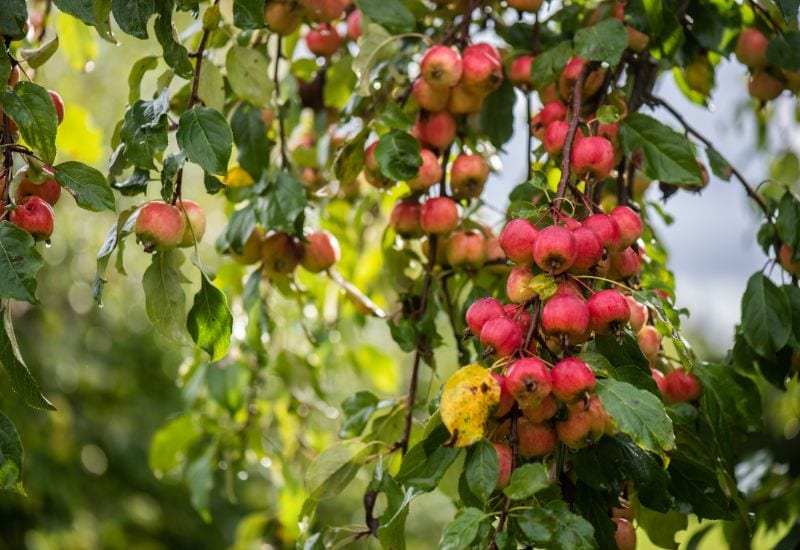
Our journey leads us to a few species from the Malus (apple) genus, that are commonly grouped under the name of crabapples, mainly Malus sylvestrisfrom Europe, Malus baccata, Malus sargentiiand Malus doumeriand Malus floribundafrom Asia, and Malus ionensisfrom North America.
Blooming in mid and late spring, these cosmopolitan trees all give you really impressive displays, becoming an explosion of single rose like flowers. This jaw dropping spectacle is not very long lived, but it will last more than in most fruit tree varieties, and you can pick many colors.
For example, the cultivar with a columnar habit ‘Centurion’ will inject energy to your driveway with its fragrant and deep rose blossoms, while ‘Camelot’ has romantic pink, ‘Indian Summer’ lavender magenta, and ‘Downland Wyman’ shines in pure white.
Loved by pollinators, the blooms will give way to the actual fruits that ripen to red, and they are edible, though they can be sour, so, we mainly use them for jams and cider!
Most varieties have a round crown of deciduous leaves, deep green and oval in shape, but blushing up to warm yellows and oranges as fall approaches, like the Sun setting on their upright and dark trunks.
All crabapple varieties will work wonderfully well on countryside and traditional looking open driveways, but you could also use it for a a Japanese cherry blossom bloom effect leading to your main door, even in a cold region. And they are also suitable for small spaces.
18: Hong Kong Orchid Tree (Bauhinia x blakaena)
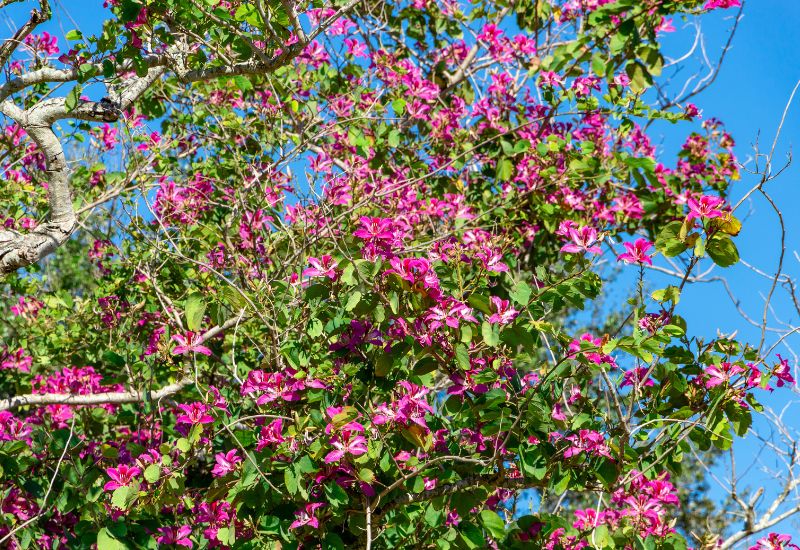
We close our drive with a hybrid of Bauhinia variegata(which you can use as well), native to Australia, Bahamas, Cuba, Florida and New Caledonia, but it is called Hong Kong orchid tree! It looks like this well traveled plant is perfect to end our journey, and do it in style!
Of course, its most famous trait are its amazing blooms, which do remind us of orchids, with their clearly spaced petals, dive of them, but without one at the bottom, gently curling at the tips, and of a bright rose tonality with white veins.
But the upper one has a deep magenta and crimson blush, like a plume, and the upward arching stamens and long pistils project forward, but also an exotic beauty!
And these striking flowers will come abundantly from late fall to spring, attracting pollinators with their sweet fragrance. Each blossom is about 6 inches across (15 cm), and it will turn into a long and bean like pod, dangling for months, and – yes, they are edible!
But the spreading and round crown on top of the upright trunk is no less spectacular, with its large leaves, with two broad and round lobes, emerging copper and then turning bright then rich green till they drop in fall.
You can surely imagine the spectacle that growing Hong Kong orchid tree can create on the sides of your driveway, all year round, with its blooms, pods and exotic leaves, and it is not a big tree, so, you can grow it even in a modest sized garden!
Wonderful Trees from All Over the World, Ready to Come to Your Driveway!
we have traveled all over the world to find trees to line your driveway… And, no matter if your garden is big or small, informal or formal, countryside or urban, traditional or exotic, one of these stunning varieties is still waiting for you… and if our journey together ends here, yours has only just started…

Written By
Amber Noyes
Amber Noyes was born and raised in a suburban California town, San Mateo. She holds a master’s degree in horticulture from the University of California as well as a BS in Biology from the University of San Francisco. With experience working on an organic farm, water conservation research, farmers’ markets, and plant nursery, she understands what makes plants thrive and how we can better understand the connection between microclimate and plant health. When she’s not on the land, Amber loves informing people of new ideas/things related to gardening, especially organic gardening, houseplants, and growing plants in a small space.

